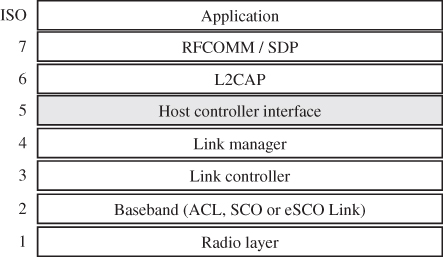7.4 The Bluetooth Protocol Stack
Figure 7.4 shows the different layers of the Bluetooth protocol stack and will be used in the following sections as a reference. The different Bluetooth protocol layers can only be loosely coupled to the seven-layer OSI model, as some Bluetooth layers perform the tasks of several OSI layers.
Figure 7.4 The Bluetooth protocol stack.

7.4.1 The Baseband Layer
The properties of the physical layer, that is, the radio transmission layer, have already been described. On the basis of the physical layer, the baseband layer performs the typical duties of a layer 2 protocol, such as the framing of data packets. For the data transfer, three different packet types have been defined in the baseband layer.
For packet data transmission, Bluetooth uses Asynchronous Connectionless (ACL) packets. As shown in Figure 7.5, an ACL packet consists of a 68- to 72-bit access code, an 18-bit header and a payload (user data) field of variable size between 0 and 2744 bits.
Figure 7.5 Composition of an ACL packet.

Before the 18 header bits are transmitted, they are coded into 54 bits by a forward error correction (1/3 FEC) algorithm. This ensures that transmission errors can be corrected in most cases. Depending on the size of the payload field, an ACL packet requires one, ...
Get From GSM to LTE: An Introduction to Mobile Networks and Mobile Broadband now with the O’Reilly learning platform.
O’Reilly members experience books, live events, courses curated by job role, and more from O’Reilly and nearly 200 top publishers.

